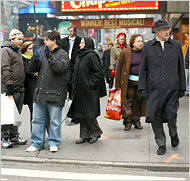A graduate school application can go sour in as many ways as a blind date. The personal essay might seem too eager, the references too casual. The admissions officer on duty might be nursing a grudge. Or a hangover.
Rachel Riskind of Austin, Tex., nonetheless has a good feeling about her chances for admittance to the University of Michigan’s exclusive graduate program in psychology, and it’s not just a matter of her qualifications.
On a recent afternoon, as she was working on the admissions application, she went out for lunch with co-workers. Walking from the car to the restaurant in a misting rain, she saw a woman stroll by with a Michigan umbrella.
“I felt it was a sign; you almost never see Michigan stuff here,” said Ms. Riskind, 22. “And I guess I think that has given me a kind of confidence. Even if it’s a false confidence, I know that that in itself can help people do well.”
Psychologists and anthropologists have typically turned to faith healers, tribal cultures or New Age spiritualists to study the underpinnings of belief in superstition or magical powers. Yet they could just as well have examined their own neighbors, lab assistants or even some fellow scientists. New research demonstrates that habits of so-called magical thinking — the belief, for instance, that wishing harm on a loathed colleague or relative might make him sick — are far more common than people acknowledge.
These habits have little to do with religious faith, which is much more complex because it involves large questions of morality, community and history. But magical thinking underlies a vast, often unseen universe of small rituals that accompany people through every waking hour of a day.
The appetite for such beliefs appears to be rooted in the circuitry of the brain, and for good reason. The sense of having special powers buoys people in threatening situations, and helps soothe everyday fears and ward off mental distress. In excess, it can lead to compulsive or delusional behavior. This emerging portrait of magical thinking helps explain why people who fashion themselves skeptics cling to odd rituals that seem to make no sense, and how apparently harmless superstition may become disabling.
The brain seems to have networks that are specialized to produce an explicit, magical explanation in some circumstances, said Pascal Boyer, a professor of psychology and anthropology at Washington University in St. Louis. In an e-mail message, he said such thinking was “only one domain where a relevant interpretation that connects all the dots, so to speak, is preferred to a rational one.”
Children exhibit a form of magical thinking by about 18 months, when they begin to create imaginary worlds while playing. By age 3, most know the difference between fantasy and reality, though they usually still believe (with adult encouragement) in Santa Claus and the Tooth Fairy. By age 8, and sometimes earlier, they have mostly pruned away these beliefs, and the line between magic and reality is about as clear to them as it is for adults.
It is no coincidence, some social scientists believe, that youngsters begin learning about faith around the time they begin to give up on wishing. “The point at which the culture withdraws support for belief in Santa and the Tooth Fairy is about the same time it introduces children to prayer,” said Jacqueline Woolley, a professor of psychology at the University of Texas. “The mechanism is already there, kids have already spent time believing that wishing can make things come true, and they’re just losing faith in the efficacy of that.”
If the tendency to think magically were no more than self-defeating superstition, then over the pitiless history of human evolution it should have all but disappeared in intellectually mature adults.
Yet in a series of experiments published last summer, psychologists at Princeton and Harvard showed how easy it was to elicit magical thinking in well-educated young adults. In one instance, the researchers had participants watch a blindfolded person play an arcade basketball game, and visualize success for the player. The game, unknown to the subjects, was rigged: the shooter could see through the blindfold, had practiced extensively and made most of the shots.
On questionnaires, the spectators said later that they had probably had some role in the shooter’s success. A comparison group of participants, who had been instructed to visualize the player lifting dumbbells, was far less likely to claim such credit.
In another experiment, the researchers demonstrated that young men and women instructed on how to use a voodoo doll suspected that they might have put a curse on a study partner who feigned a headache. And they found, similarly, that devoted fans who watched the 2005 Super Bowl felt somewhat responsible for the outcome, whether their team won or lost. Millions in Chicago and Indianapolis are currently trying to channel the winning magic.
- 1
- 2
















